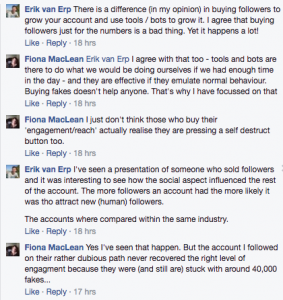Social followers: a numbers game
When it comes to working with digital Influencers over social media, top line numbers are still the first thing that many brands, destinations and agencies look at. Many people working in digital marketing or as an Influencer know that this is far from the only metric to use, but despite how easy is has become to grow large accounts with ‘fake’ followers, it’s still the first thing that everyone looks at. It stands to reason, then, that when Influencers look to build their channels and turn them into a source of income and opportunities, the number one task is to get those numbers up. This is where the problems start, there are more than a few ways to gain followers, fans and views when it comes to platforms such as Instagram, Twitter, Facebook and YouTube, some are honest, some are not and some sit perfectly on that blurred line between the two.
For the sake of the examples in this article, we’re going to use Instagram as the platform of focus, but you can translate Instagram followers into YouTube views, or Facebook fans, and nothing much would change.
How do you gain followers?
With any platform, content should come first. Post good images, caption them well, and people will follow you. Although we all know that it’s far from that simple.
When it comes to purely acquiring followers for existing content, the main ways to do this for Instagram are by following, liking and by commenting (calling that FLC for the rest of this article), on other posts. These are the three actions that send notifications to the other people who have accounts (the ones on which you have commented, liked or followed).
There are, again, many ways to use FLC as a strategy. The simplest of these is to manually go on to Instagram, find the images you like by accounts you want to engage with, and take action. But this is time consuming. So what comes next? Let’s take a look at some of the ways in which people can execute the FLC strategy on their own channels.
Virtual Assistants
Many Influencers now use virtual assistants (VAs) for helping with a whole manner of work, and a big part for lots of people is follower acquisition. The VA will use Instagram on the account holder’s behalf and find the right accounts and images to follow.
Outsourcing
There are many websites that offer a cheap solution to gaining followers using lower cost labour in countries where this is possible. For example, people working from home in Thailand or from a converted warehouse in Bangladesh. The people, or their companies, can offer a set amount of follower in exchange for a low payment. £5 can get you 400 followers on Instagram, or a day of work. The people working have no connection to the Influencer beyond the exchange of data and money. They don’t have as much information to be searching for the ‘right’ accounts, to comment in a personal way or follow those that would usually fit the mould for the Influencer.
Bots
The cheapest way there is. Bots run programs to automatically find images and accounts to follow, like and comment on. The comments are usually very plain ‘great pic’, ‘love your stuff’ and such. These programs work 24/7 and can be very effective. They can search based on hashtags, location and more to find the images closest to being accurate. But the problem is that they don’t look at the image, and it can lead to some very questionable comments being left, ‘wow, so amazing!’ on a funeral shot, for example.
“Buying followers and likes is a way of destroying any social media platform in the medium term. If brands don’t get a return on investment from working with apparently high follower/high engagement Influencers, they will stop doing so altogether. And, that means everyone suffers – including those who are faking it. It’s sad, selfish and short-termist.”
Fiona MacLean, London Unattached.
So those are the four main ways to look at an FLC strategy, and it’s clear that some are more morally right than others. But the question is; where do you draw the line?
Using bots is, most would agree, wrong. But people do it, huge Instagrammers, respected bloggers, multinational corporations and more. Because it’s cheap, easy and effective. The followers that you gain from this are not usually a high calibre, some are even fake accounts, set up just to do this. You can tell that by looking at the levels of engagement on images. But many brands still don’t take this into account. If someone has 20 times the follower numbers as someone else, yet their engagement levels are the same, there should be questions asked as to why. Who are the people following them? Where did they come from? I could easily write 10 articles on how to detect questionable accounts, what to look for, why not to work with them and more. So for now we’ll just stick to what is right, what is wrong, and what is a bit of both.
“I think that some Influencers are buying social media followers as a result of the pressure many brands put on when they only consider numbers in choosing who to work with on their projects. And this is so wrong… I have always believed that 500 engaged followers who trust the Influencer are much more valuable than 100,000 passive ones.”
Joanna Davis, The World in my Pocket.
Next up is outsourcing. In my opinion this is just the same as using bots. The people who are personally working on this are, of course, not programs, but they way they work is the same. Logging in, looking for images, commenting, liking, following and leaving. There is zero personal interaction behind what they post and the comments will also be standard and reusable, not personal to the image they’re commenting on.
VAs are, for me, the place where the massive question mark hangs. The grey area. Of course some VAs are just like PAs, and some are as involved with the Instagrammer in question to a level that means they do really ‘know’ what they’re doing, what is liked, what is not, where is appropriate to comment and how to comment personally and with meaning. But, they’re still not the person running the account. The account where people think they’re interacting with the person in the profile pic, the couple on the beach sharing shots of their honeymoon or recommending which travel accessories to use this summer. Some VAs also run many accounts, so they lose the level of personalisation that you’d hope to get, moving them closer to being another version of outsourcing, one step away from a bot.
“Yes, there are a lot of bad bots, but not all of them are just to spam. For analyzing purposes I wrote my own “bot” (on a new separate account) and I can say it worked really well. If you make it human enough, let it help you in doing the same as you would do as a human, but now in an automated way. Then it can reduce the workload, help you find really good targeted followers who are likely to interact with your posts and it can make your account better and bigger.
Is a social media account of a (human) blogger who follows and engage with each other bloggers (instead of relevant people) more valuable than a bot who will try to help you find and engage with “your” targeted customer to grow your following? I personally would go for the bot as I would rater have relevant people to follow me than other bloggers.”
Erik Van Erp, Around the Globe.
These are all just my opinions, I once spoke to a great blogger with a huge Instagram account, she told me that to gain followers you should be looking at FLC, along with the stunning shots of London, food and travel she posts. But when I executed that myself I started, quickly, to become bored and tired with it. Successfully running large social accounts is hard work, and even personally commenting and following, as I was, I noticed my interactions start to turn very bland, I was searching for images on hashtags and leaving dull comments.
How should brands avoid falling for tricks then? Well, the answer is to do your research, or use people who know the game better than you do. Agencies or freelancers that have expert knowledge, as well as years of experience on their side. The short answer really is that there is no quick fix, each Instagrammer needs to be looked at and red flags will start to pop up. This is the same of any social network. On Instagram it’s engagement on their own pictures, on Facebook it’s the same. On Twitter, look at why someone has 30,000 followers but nobody’s talking to them. YouTube; why would one video (or a series) have 5,000 views while most videos get 50, why has nobody who owns those 5,000 sets of eyeballs commented or given a thumbs up?
“I know of travel brands with millions of fake followers and I also know of massive Influencers who use bots that brands know about and still work with them so what makes it a really grey area as you as sometimes your not fooling brands (as they will still work with you) & brands are actually fooling the public. The idea of buying followers gets even more blurry if you consider Facebook & Instagram advertising & boosts could be considered buying followers & engagement and sadly the game brands & bloggers have to play because of changing algorithms.”
Simon Lewis, Travel Concept Solution.
The only way to make these practices go away is to stop rewarding their use. People don’t need to be publically named and shamed, but they shouldn’t be invited on campaigns, paid for speaking at events or given lucrative freelance work if they are clearly buying their stats. The reason for writing this article is that a major brand that I respect and have a lot of time for has for years been putting themselves out there as one of the few that really ‘get’ how to properly use Influencer marketing. Last week I saw this same brand working with an Influencer whose stats make him among the most obvious out there for bought and fake followers.
I wonder if this company, one that talks of their own team of experts, their own coded algorithms and industry-leading campaigns, can’t get it right, who can?




Great article. It always amazes me that companies don’t consider the engagement level to be critical. Numbers in themselves mean nothing. I’ve seen accounts on Facebook with a million followers and an engagement level of less than .1%. Everyone wants a quick fix but in the long term it doesn’t work. I have 118k followers on Facebook, grown totally organically by sheer hard work – writing real content and valuing those who follow me. I interact with those who like and comment and yes it is time consuming and hard work but they are all potential clients to me. With a consistent engagement level of 30% – I think it’s worth it.
Great issue. As an Instagrammer who works other platforms, it’s galling how money (for PA’s, VA’s, bots, Ads, etc.) pulls one ahead of great content and engagement. I’ll keep working it and I do see some PR’s, CVB’s, DMO’s starting to catch on. Multi-media and multi-outlets is working for me but it can be so exhausting!